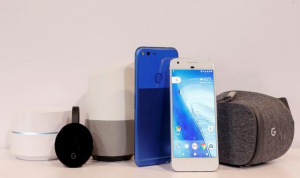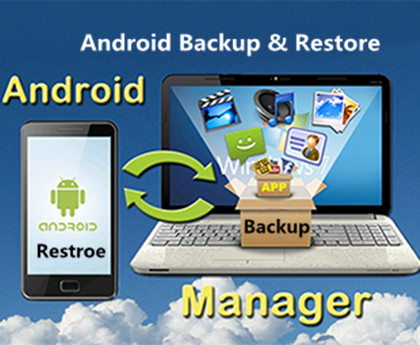By Selena KomezUpdated on October 08, 2016
Google unveiled new hardware from Pixel smartphones and smart speakers to wireless routers on Tuesday. It was a year-long odyssey that involved design, supply chain negotiations and the search for a manufacturing partner.
Now the Alphabet Inc. unit must grapple with the equally daunting challenge of getting the gadgets to consumers. It has a history of retail strategies that either struggled or never got off the ground, according to people familiar with the company’s retail efforts. What’s more, it’s inexperienced dealing with returns and recycling. And unlike rival Apple Inc., the company lacks its own stores where it can showcase hardware as it pleases and instead relies on other companies’ in-store displays.

This time, the stakes are higher because the latest gadgets are vehicles for Google’s digital assistant, a key product that is chasing Amazon.com Inc.’s Alexa and Apple’s Siri.
“We view go-to-market as a clear hurdle to wide acceptance, which will require investments in brand, marketing and distribution to overcome,” UBS analyst Eric Sheridan wrote in a note to investors.
Google is selling the new Pixel phones at Verizon Communications Inc. and Best Buy Co. stores in the U.S., via its own online store, a temporary physical store in New York City and through its wireless service Project Fi. It’s working with a small number of other wireless carriers and retailers in countries including Germany and India. Google Home, the new speaker, is available at Best Buy, Wal-Mart Stores Inc. and Target Corp. stores, in addition to Google’s online store.
Cutting distribution deals with a handful of carriers and retailers isn’t enough, according to Forrester Research analyst Thomas Husson. “Google will have to up its customer-service game and do many more distribution partnerships,” he said.
Many of Google’s past efforts at selling hardware have fizzled. When the company started its Nexus brand in 2010 it planned to market the phones online only, but sales never took off. About 200,000 of the first Nexus model sold, short of Google’s target of several million units, according to a person who worked on the device.
Then there was Android Silver. Kicked off some time in 2014, the internal project was designed to sell high-end Android handsets with partners to compete with Apple. Google set up a retail lab for the effort, claiming an entire building near its Mountain View, California headquarters, according to former employees. But it never got off the ground. Nikesh Arora, Google’s sales chief at the time, drove the initiative. When he left in July 2014, Android Silver was shelved. One former Google executive called it a boondoggle.
The former Googlers didn’t want to be identified discussing private information. A Google spokeswoman declined to comment.
Apple Envy
Such experiments are a contrast to Apple stores that are the envy of the retail industry. Apple considers the iPhone in terms of the product’s complete life cycle, from leaving the factory to when customers stop using the device. Apple offers a recycling program through physical and online stores.
Google’s new smartphone unit approached potential wireless carrier partners early this year, according to a person familiar with the situation. Some carriers peppered Google executives with questions about handling phone returns and technical support, the person said. At the time, Google did not appear ready to take on these aspects of the phone hardware business, according to this person.
Google executives on the hardware team say the company is on a “journey,” gaining experience and capabilities with each smartphone generation. And Apple only began touting the iPhone’s full life cycle after a few generations.
Google Event
On Tuesday, as a Google event began in San Francisco, new hardware chief Rick Osterloh reassured the audience that the company was serious about the move. “We’re in it for the long run,” he said.
About nine months after initial talks with carriers, Google rolled out its flavor of technical support: Pixels have built-in chat support where customer-service reps can take over smartphone screens to identify problems.
Google will be responsible for returns and recycling and is building a supply chain that can re-absorb faulty and rejected devices, Osterloh said in a recent interview.
Osterloh will be partly judged by how many devices Google sells, a contrast to the Nexus program which showcased Android features for other handset makers to adopt. But the executive was still cagey about the company’s sales aspirations.
“In markets where we do business, we’re definitely going to want meaningful share,” he said. “But it’s highly unlikely that the primary driver will be to be in every market with as high as possible volume.”
Google still sees software as its edge, rather than retail distribution and customer service. The company spent more time on Tuesday talking about the digital assistant baked into its new gadgets, and how they work together.
If Google can get millions of people relying on its assistant, the company may be able to compete with Apple’s devices, according to Brian Blau, an analyst at Gartner.
“The AI assistant will give them something that Apple has enjoyed for many years: Lock-in to the system,” he said.
Read More:
Goodbye, Nexus! Hello, Pixel Phone
The Google Pixel Phone is Exactly what you Wanted
How to Recover Deleted Data from Pixel
How to Transfer iPhone Data to Pixel
How to Transfer Android Data to Pixel
How to Backup & Restore Data on Pixel
Prompt: you need to log in before you can comment.
No account yet. Please click here to register.
